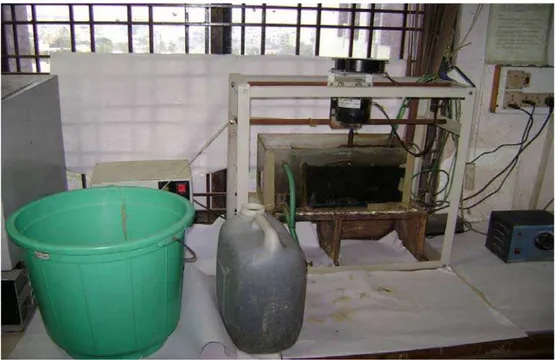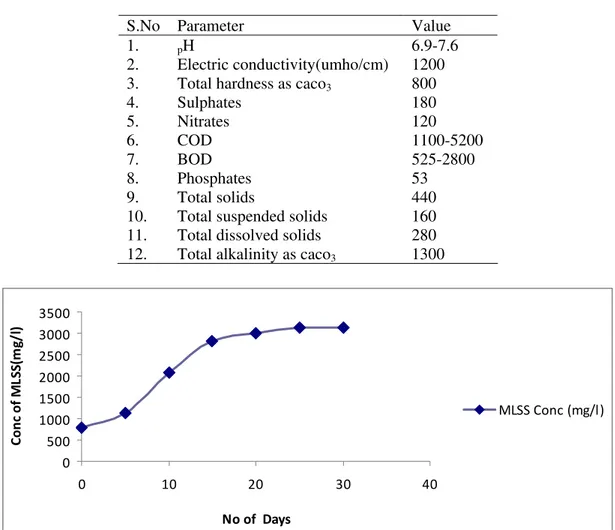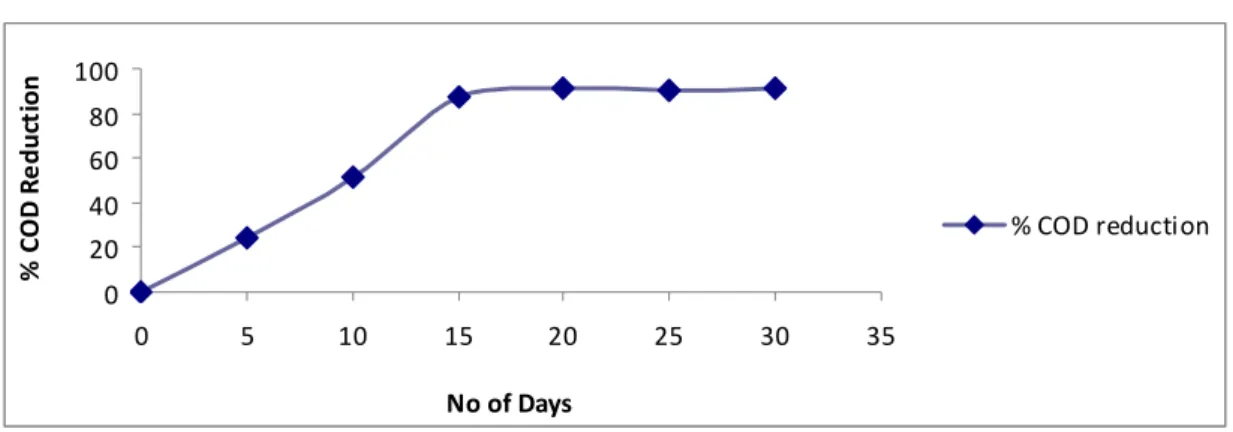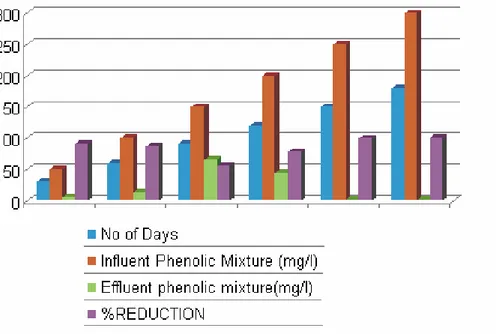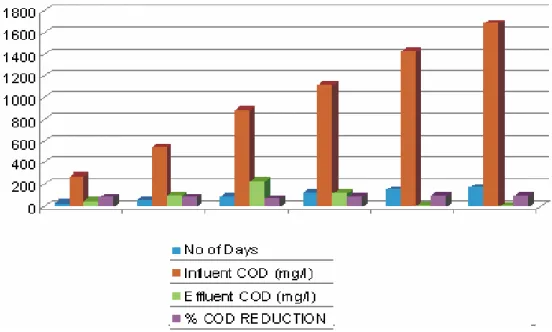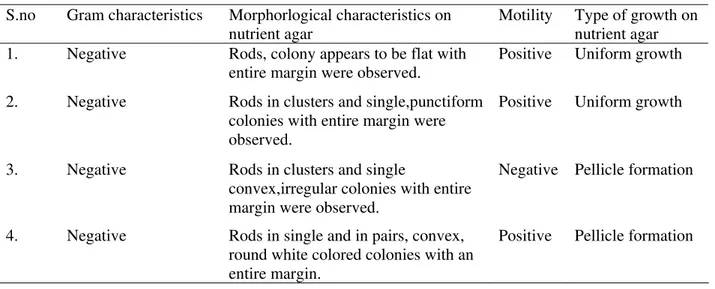E
NERGY AND
E
NVIRONMENT
Volume 2, Issue 1, 2011 pp.151-160
Journal homepage: www.IJEE.IEEFoundation.org
Degradation of mixture of phenolic compounds by activated
sludge processes using mixed consortia
M. Rajani Rani, D. Sreekanth, V. Himabindu
Centre for Environment, Institute of Science and Technology, Jawaharlal Nehru Technological University Hyderabad, Kukatpally Hyderabad-500 085, India.
Abstract
This study describes the feasibility of aerobic treatment of wastewater having mixed Phenolic compounds (phenol, 2-4dinitrophenol, 2-4dichlorophenol, 4-chlorophenol, 4-nitrophenol) by using 9L lab scale Activated Sludge Process (ASP) at HRTs (Hydraulic Retention Time) varying between 3.0 ,2.5, 2.0, 1.5 and 1 day. Continuous monitoring of parameters like pH, Oxidation Reduction Potential (ORP), Chemical Oxidation Demand (COD) , compound reduction is used to asses the treatment efficiency of ASP. The highest percentage COD removal and percentage compound reduction of 98% and 99.3% of phenol was observed at 3.0 d HRT respectively. After treatment pollutants are removed in the order of phenol > 4chlorophenol (4CP) > 4nitrophenol (4NP) > 2-4dichlorophenol (2-4DCP) > 2-4 dinitrophenol (2,4DNP). The dissolved oxygen concentration and pH in the activated sludge reactor was found to be 1-3 mg/L and 7-8 respectively. The optimum biomass concentration was 2500-3000 mg/L, whereas the corresponding SVI was found to be around 70mL/g. The morphological characterization of aerobic granules was carried out by using SEM. Thus the results obtained indicate that ASP could be used efficiently for the treatment of wastewater containing mixed phenols.
Copyright © 2011 International Energy and Environment Foundation - All rights reserved.
Keywords: Activated sludge process, Aerobic treatment, 2-4DCP, 2-4DNP, Phenol.
1. Introduction
ability to completely mineralize toxic organic compounds. The main advantage resulting from the microbial consortium formed by acclimated activated sludge is the interaction between all the species present in flocs [10]. Most of the studies are carried out by using ASP for the treatment of phenol and cyanide containing wastewater [11], Pharmaceutical wastewater [12], Molasses wastewater [13], treatment of organic pollutants [14], and biomass activity test in ASP [15]. In the scientific literature single target compounds are estimated and only few information is obtained on the mixture of different phenolic compounds. A few studies were carried out on the degradation of mixed phenolic compounds by using aerobic batch reactor [16]. No study was carried out on the degradation of mixed phenolic compounds by using ASP. So in the present study an attempt has been made to evaluate the performance of lab scale activated sludge processes for the treatment of phenolic compound mixture.
The specific objectives include
1) Biodegradation of mixture of persistent compounds: phenol, 2-4 dichlorophenol, chlorophenol, 4-nitrophenol and 2,4di4-nitrophenol by mixed consortia in activated sludge process.
2) To investigate the effect of HRT (3.0, 2.5, 2.0, 1.5 and 1.0) on the reactor performance.
3) Optimization of parameters like pH, SVI, MLSS, Dissolved oxygen for the degradation of mixture of phenolic compounds.
4) After the treatment the morphological characterization of aerobic granules using SEM analysis was carried out.
5) Cost estimation analysis has been carried out for the degradation of phenolic mixtures. 6) Microbial analysis of sludge at different HRTs are studied.
7) Cost estimation for the biodegradation of phenolic mixtures are studied.
2. Materials and methods
2.1 Chemicals
Phenol, 2-4DCP, 2, 4DNP, 4CP, 4NP was in granular form (purity>98%) and supplied by Merck., India.
2.2 Experimental apparatus
ASP reactor (Figure 1) is of 11L capacity with two chambers of which one is for aeration (9L) and other for settling (2L). Aeration was achieved by stirrer and submerged aeration was achieved by air compressor which is arranged at bottom of the aeration tank to facilitate uniform and effective mixing. Peristaltic pumps were used to supply the feed to the reactors and were calibrated to determine the required flow rate. The excess suspended solids (SS) in the reactor are wasted periodically and hence a constant SS values were maintained in the reactor.
2.3 Start up of the reactor
The activated sludge required to start the reactor was obtained from Jeedimetla Effluent
Treatment Plant, Hyderabad. This sludge has a concentration of TSS of between 30 and 35 g/L, 90% being VSS, and its SVI was 70 ml/g. The reactor was filled with this sludge up to 1/3 of its volume and was fed with a synthetic water as carbon source and adding the necessary nutrients for bacterial development. The pH in the reactor ranged between 7.0 to 8.0. The reactor was stabilized and the oxygen concentration in the reactor was maintained around 1-3mg/l. The characteristics of the synthetic wastewater is given in Table 1. Reactors are operated in continuous mode. COD: N: P ratio was maintained around100:5:1. During start-up period phenols were not added to the reactor. HRT of the reactors was maintained at 1day. Initially the MLSS concentration was 800mg/L and the concentration increased to 20 days and after stabilized at around 3000mg/L (Figure 2). The COD% reduction was low initially but latter on proper acclimation to microorganisms the COD% reduction was increased to 80% where steady state of the system was acquired (Figure 3).
Table 1. Characteristics of sewage used in the study
S.No Parameter Value
1. pH 6.9-7.6
2. Electric conductivity(umho/cm) 1200 3. Total hardness as caco3 800
4. Sulphates 180
5. Nitrates 120
6. COD 1100-5200
7. BOD 525-2800
8. Phosphates 53
9. Total solids 440
10. Total suspended solids 160 11. Total dissolved solids 280
12. Total alkalinity as caco3 1300
0 500 1000 1500 2000 2500 3000 3500
0 10 20 30 40
No of Days
Co
n
c
of
M
L
SS(
m
g
/
l)
MLSS Conc (mg/l)
Figure 2. No. of days Vs MLSS conc during startup of the reactor
2.4 Acclimation of activated sludge reactor with phenol, 2-4DNP, 2-4DCP, 4-CP, 4NP
0 20 40 60 80 100
0 5 10 15 20 25 30 35
No of Days
%
CO
D
R
e
duc
ti
on
% COD reduction
Figure 3. No of days Vs % COD reduction during staetup of the reactor
2.5 Analytical methods
Analysis of alkalinity, chlorides, nitrates, total suspended solids and COD were conducted in accordance with Standard Method [17]. Phenol, 2-4DNP, 2-4DCP, 4-CP and 4NP concentration was measured by Systronics-1272 UV-visible Spectrophotometer at 236nm and further confirmed by reverse phase high-performance liquid chromatography. Agilent Technologies HPLC was used with Chemosoft software. Column used was C-18 with mobile phase having a mixture of methanol and water in the ratio of 80:20. The flow rate was 1ml/min with retention time of 5min.
2.6 Toxicity test
The acute toxicity test was performed to evaluate the detoxification using Daphnia magna. The toxicity was expressed as effective concentration 50 (EC50) concentration/dilution, which produces the immobility of 50% of the organisms of the population tested after a period of exposure of 24 to 48 h. The organisms sensitivity was evaluated before the bioassays are performed. Potassium dichromate was used as a reference toxic compound. General conditions of exposure are showed in the Table 2.
Biodegradation assays and toxicity was evaluated in samples taken both at the beginning and also at the end of the reaction in the influent and effluent of the activated sludge reactor.
Table 2. Conditions of exposure of the acute toxicity test carried out with Daphnia magna
Exposure type Static without water exchange
Temperature 20
Light No illumination
Dilution water Reconstituted distilled water
pH 7.8+0.2
Hardness 250+25mg CaCo3 L-1
Dissolved oxygen 80% of saturation
Conductivity 170 Size of the container 20 ml test tubes
Volume of the sample 10 ml
Age of the organisms 6-24 h
Number of organisms/test 5
Number of triplicates 4
Total number of test organisms 20
Feeding No feeding
Aeration No aeration
Test duration 24-48 h
Measure effect Immobilization
2.7 Aerobic granules
Aerobic granules were cultivated using different HRTs ranging from 3 to 1 d, and the results showed that HRT played a role in shaping granule characteristics and reactor performance. Reactors were inoculated with aerobic granules cultivated from activated sludge. These seed granules have a specific gravity (SG) of 1.64 g cm3, a mean diameter of 0.88 mm and an IC of 99.5%. The aim of this study is to evaluate the effect of HRT on the development of aerobically grown microbial granules.
2.8 Microbial analysis of activated sludge
The activated sludge used in the present work was subjected to microbial analysis to know the probable microorganisms involved in the biodegradation of waste. Various media and stains used in the analysis were procured from M/s Hi-Media, Bombay. Various dilutions of activated sludge were used to determine the total plate count and a loop full of this diluted culture was subjected to microbial analysis using standard procedures. A loop of culture was streaked on Nutrient Agar (NA) for bacteria and Potato Dextrose Agar (PDA) for fungi. These plates were incubated at room temperature (30+20C) for 24-48 hours and observed for growth.
3. Results and discussions
It was observed that after 60 days stepwise increase in phenolic mixture concentration up to 150mg/L caused inhibition to the performance of the reactor and the removal efficiencies are 56%. But the removal efficiencies further increased to 99% from 90th day onwards having low effluent concentration of 1.4 and 0.8mg/L (Figure 4). The reason may be due to the sufficient acclimatization provided for the successful degradation of phenolic compounds. The COD removal percentage gradually decreased with decrease in HRT. This may be due to the inhibitory effect of higher concentrations on the treatment efficiency. The COD removal efficiency dropped to 74%. Initially, this is due to the inhibitory effect of phenolic mixtures on the reactor performance. But later on the COD removal efficiency recovered to 99.7% from 89.2% (Figure 5). It can be concluded from the study that COD% reduction decreased by providing the sufficient time to microorganisms to adjust to new feed composition. The degradation of each phenolic compound decreased with increase in pollutant loading rate. However the pollutants were removed in the following order phenol > 4CP > 4NP > 2,4DCP > 2,4 DNP (Figure 6). This is may be due to the following reason that, greater the number of substituents in structure the more toxic recalcitrant and less degradable [18]. The release of chlorides in the degradation of 4CP, 2-4DCP was observed and analysed. The similar results was obtained by Shu-Guang Wang et al in the biodegradation of 2,4DCP in sequencing batch reactor [19].
Figure 5. Percentage of COD reduction during the treatment of mixed phenolic compounds
0 20 40 60 80 100 120
0 50 100 150 200 250 300 350
Phenolic Mixture Concentration Rate (mg/ltr)
R
e
mo
val
E
ff
ic
ien
cy
i
n
%
phenol 4cp 4np 2-4dcp 2-4dnp
Figure 6. Phenolic compounds removal order
3.1 Hydraulic retention time (HRT)
Table 3. Percentage removal for phenolic mixture at various HRTs
HRT (days) COD Removal % Phenolic Mixture Concentration (mg/ltr) Inffluent Effluent
Chlorine release efficiency (mg/ltr)
3.0 98 300 2.0 8.6
2.5 97.3 300 2.1 7.5
2 94.5 303 2.0 6.6
1.5 94 301 2.4 8.4
1.0 93 300 2.5 9.2
3.2 Operational parameters
Sludge volume index is one of the important parameter to asses the stability of the sludge in suspended growth systems like ASP with increase in pollutant loading rate, SV decreased. This may be attributed to the fact that increase in pollutant loading rate increased the toxic load in the effluent, there by causing inhibition to the native biomass growth and its metabolic activities. The SS was in the range of 2500-3000mg/L. With increasing the loading rates the MLSS decreased rapidly indicating the toxic nature of the influent feed. The F/M ratio was in the range of 0.2 to 0.4 which is optimum for good systems. However the F/M ratio was quite high after increasing the loading rate which indicates the inhibition due to toxicity.
3.3 Oxidation reduction potential
The oxidation and reduction potential system depends on the activity of the microbial consortia. It is useful in the evaluation of magnitude, characteristics and process change. When the ORP is in between +400mv and +20mv aerobic system prevails. In the present study ORP was continuously monitored and observed to be between 50mv-50mv throughout the study, confirming the optimum aerobic conditions prevailing in the reactors.
3.4 Effect of pH
Biological systems are dependent on the pH change, which are bought about by the oxidation and reduction of various substrates in the process. Activities of microorganisms are more in a specific pH value. Aerobic systems work in pH range of 6.5-8.5. The pH of the effluent from the process was continuously monitored throughout the study. It was observed to be between 8.0-8.25.
3.5 Toxicity test
The high average levels of toxicity are expressed by EC50 h of 0.7% v/v were found in the feeding of the activated sludge reactor. Due to high percentages of removal of mixed phenolic compounds, the samples taken from the effluent does not contain any toxicity. The absence of toxicity may be explained by the presence of heterogeneity of the organisms such as algae, rotifers and ciliates. These results are significant because according to Argentine National Act on hazardous Wastes (Act 24051/92) and its regulating Decree, (Decree 830/93) toxicity is an essential characteristic which identifies hazardous waste. So these findings may help in the treatment of industrial effluents and bioremediation of environments polluted by phenolic compounds. These values are similar to that of A.Gallego et al.,2003 findings for the treatment of phenolic compounds [20].
3.6 Effect of HRT on the aerobic granules
3.7 Microbial analysis
The result of microbial analysis of the sludge total count (mean of 5 values) of the activated sludge at 4 different HRTs are presented in Tables 4 & 5. Quantitative analysis of microbial isolates yielded 10 ten major isolates. The isolates were mostly gram negative in nature with positive motility. The total plate count analysis carried out during the study revealed that highest cell density was observed at 3.0 HRT indicating the reduced microbial activity at higher concentrations. Further it was also observed that the counts on the nutrient agar (bacterial ) was more than those of PDA (fungal) indicating good sludge characteristics for effective settleability.
Table 4. Quantitative analysis of the microbial isolates from activated sludge
S.no Gram characteristics Morphorlogical characteristics on nutrient agar
Motility Type of growth on nutrient agar 1. Negative Rods, colony appears to be flat with
entire margin were observed.
Positive Uniform growth
2. Negative Rods in clusters and single,punctiform colonies with entire margin were observed.
Positive Uniform growth
3. Negative Rods in clusters and single
convex,irregular colonies with entire margin were observed.
Negative Pellicle formation
4. Negative Rods in single and in pairs, convex, round white colored colonies with an entire margin.
Positive Pellicle formation
Table 5. Total plate count (CFU/ml) of the activated sludge
S.no HRT dilution Cell count on NA
X2 S.D
Cell count on PDA X2 S.D 1. 2. 3. 4. 5. 6. Raw effluent 3.0 2.5 2 1.5 1.0 Undiluted 10 10 10 10 10
2 ± 0.76 140 ± 13.75 116 ± 20.8 98 ± 15.68 76 ± 28.47 84 ± 23.4
Nil 40 ± 17.75 27 ± 25.40 36 ± 23.60 24 ± 20.85 41 ± 30.0
3.8 Cost estimation
Cost estimation was done for the present activated sludge reactor for treating the mixed phenolic compounds. The overall costs are represented by the sum of capital costs, the operating and maintenance costs. For the full scale system these costs strongly depend on the nature and the concentrations of the pollutants, the flow rate of the effluent and configuration of the reactor. An estimation costs has been made in this section regarding the operation costs for the treatment processes used for the degradation of phenol,2-4DCP, 2,4DNP,4CP and 4NP for 180days. The total estimated cost is 85.6$ for the degradation of phenolic compounds Table 6.
Table 6. Operational cost for the ASP reactor
S.No Requirement Cost US $ 1 Electricity 13.5$
2 Phenols 0.1$
3 Nutrients 72.0$
4. Conclusions
Based on the present study the following conclusions are obtained
1. The result of study showed that all five Phenolic compounds from synthetic wastewater could be treated effectively by activated sludge processes at different HRT s varying between 3.0, 2.5, 2.0, 1.5, and 1d.
2. The degradation order of phenol > 4CP > 4NP > 2,4DCP > 2,4 DNP was observed during the study.
3. The operational parameters SVI and MLSS decreased due to the toxicity of pollutant loading rate.
4. The total estimated cost for the degradation 300mg/L of phenolic compounds was found to be appx. 85.6$.
5. The highest percentage COD removal and percentage compound reduction of 98% and 99.3% of phenol was observed at 3.0 d HRT respectively.
References
[1] Edgardo M. Contrerasa., Elisa M. Albertarioa., Nora C. Bertolaa.,Noemí E. Zaritzkya. Modelling phenol biodegradation by a sludges evaluated through respirometric techniques. Journal of hazardous materials. 2008, 158,366-374.
[2] Godbole A., ChakrabartiT. Biodegradation of in upflow anoxic fixed film-fixed bed reactors of recorcinol, catechol and phenol in mono and binary substrates matrices. Water Research .1991, 25,1113-1120.
[3] Ugurlu M., Kula I. Decolorization and removal of some organic compounds from olive mill waste water by advanced oxidation processes and lime treatment. Env Sci pollutant.2007,5,319-325. [4] Walker JD. Effect of chemicals on microorganisms. JWPCF , 1989,61,1077-1097.
[5] Sreekanth D., Sivaramakrishna D. Thermophilic degradation of phenolic compounds in lab scale hybrid up flow anaerobic sludge blanket reactors. Journal of Hazardous Materials .2009,164,1532-1539.
[6] Klein J.A., Lee D.D. Biological treatment of aqueous wastes from usual conversion processes.Biotechnol. Bioeng. 1978, 8,379–390.
[7] Talley J.W., Sleeper P.M. Roadblock to the implementation of biotreatment strategies, Annuals of New York Academic of Sciences, 1997, 829,17–29.
[8] Linz, D.G., Neuhauser E.F., and Middleton A.C. Perspectives on bioremediation in the gas industry in Sayler, G.S., Fox, R. and Blackburn, J.W. (Eds.): Environmental Biotechnology for Waste Treatment, Plenum Press, New York.1997.
[9] Thavasi R., and Jayalakshmi S. Bioremediation potential of hydrocarbonoclastic bacteria in Cuddalore harbour waters (India). Res. J. Chem. Environ. 2003, 7, 17–22.
[10] Marrot B., Barrios-Martinez A., Moulin P., Roche N. Biodegradation of high phenol concentration by activated sludge in an immersed membrane bioreactor. Journal of Biochemical engineering 2006, 30.
[11] Papadimitrous C.A., Samaras P.,Sakellaropoulos. Comparative study of phenol and cyanide containing wastewater in CSTR and SBR activated sludge reactors. Bioresource Tecnology.2008. [12] Samuel Suman Raj D., Anjaneyulu Y. Evaluation of biokinetic parameters for Pharmaceutical
wastewaters using aerobic oxidation integrated with chemical treatment. Process Biochemistry.2005, 165-175.
[13] Suvilampi J., Lehtomaki A., Rintala J. Comparative study of laboratory scale thermophilic and mesophilic activated sludge processes. Water research 2005,39,741-750.
[14] Athanasios Katsoyiannis., Constantini Samara. Peristent organic pollutants (POPs) in the conventional activated sludge process; fate and mass balance. Environmental Research 2005, 97,245-257.
[15] Bridget McNichol P., John Mcgrath W., JohnQuinn P. Development and application of the resazurin based biomass activity test for activated sludge plant management. Water research.2007, 41,127-133.
[16] Maria Cornetta Toei, 2008. Env.Sci Pollutant Res 2008, 15, 188-195.
[18] Agarry S E., Durojaiye, Microbial degradation: a review, Int. J. Environmental and Pollution ,Vol .32 No. 1,2008.
[19] Shu-guang Wang et al, Chemosphere .2007,69,769-775.
[20] Gallegoa A.,rtunatoa M.S.,gliab JRossia S.,Geminia V.,Gomezb L.,Gomezb C.E., Higab LE. And Korola S.E (2003) Biodegradation and detoxification of phenolic compounds by pure and mixed indigenous cultures in aerobic reactors, International Biodeterioration and Biodegradation,52,261-267.
M. Rajani Rani, MSc BioTechnology, Nagarjuna University, Guntur, Andhra Pradesh, India, March 2001. She is working on
Water and Soil Analysis using UASB, ASP, RBC and keen to come up with economic and effective way to reduce industrial pollutants and facilitate a healthier living environment in urban and rural areas.
E-mail address:rajanimohanganni@gmail.com
D. Sreekanth has completed his masters degree in Microbiology from Bharatidasan University, Tamil nadu. He was working on
wastewater treatment technologies like UASB,ASP,RBC and Biodiesel.He had achieved four peer reviewed journal.
V. Himabindu has completed her masters in environmental chemistry from SV university and Ph.D from JNT university. She is
